With the combination of BLE, NFC and UWB, the digital key will present five major development trends
Through communication technologies such as BLE (Bluetooth), NFC, UWB, etc., the digital key turns smart terminal devices such as smartphones, NFC smart cards, smart watches and smart bracelets into vehicle keys, so as to realize keyless entry and start, and remote key authorization and personalized vehicle settings, as well as offer safer key management, comfortable and convenient experience. It will be integrated into smart mobility ecosystem in the future.
In Automotive Digital Key Research Report 2021, ResearchInChina summarizes the digital key market, suppliers, OEMs, etc., and predicts future trends.
Trend 1: From 2022 to 2025, the digital key market will maintain rapid growth
ResearchInChina’s data shows that more than 2 million Chinese passenger cars were equipped with digital keys in 2021, a year-on-year spike of 243%; the assembly rate hit 10.9%, an increase of 7.5 percentage points from the previous year. Affected by the tight supply of chips, the assembly volume of automotive digital keys in 2021 was lower than expected. In the future, as the supply of chips stabilizes, the assembly volume of digital keys will rise rapidly. By 2025, 7.84 million cars will feature digital keys, with an average growth of 38%; the assembly rate will reach 30%, with AAGR of 5 percentage points.
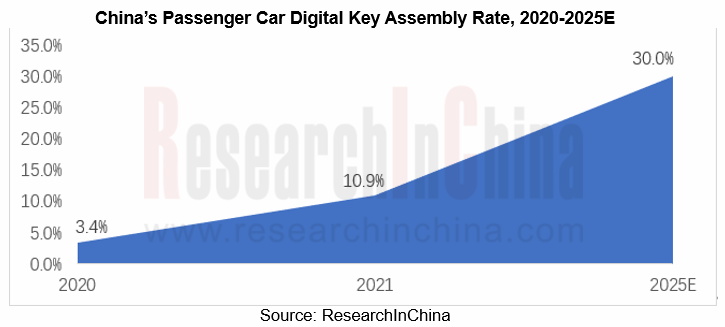
In terms of assembly volume, BYD sees the highest assembly volume of digital keys for passenger cars in China, followed by Tesla; they enjoy a combined market share of 34.6%. From the perspective of assembly rate, Tesla, Voyah, HiPhi, NIO and other emerging brands have achieved 100% assembly rate.
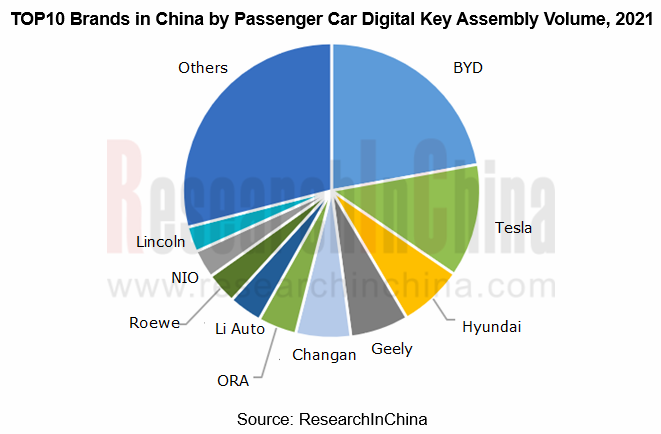
Trend 2: Bluetooth will still be the mainstream solution for digital keys in the future
In 2021, Bluetooth keys accounted for 64.2% of China's digital key mass production solutions as the most important solution. In addition, integrated solutions of Bluetooth + NFC or Bluetooth + password keys are gradually being applied by automakers. At this stage, whether it is a separate module or an integrated solution, Bluetooth acts as the most mainstream digital key communication technology.
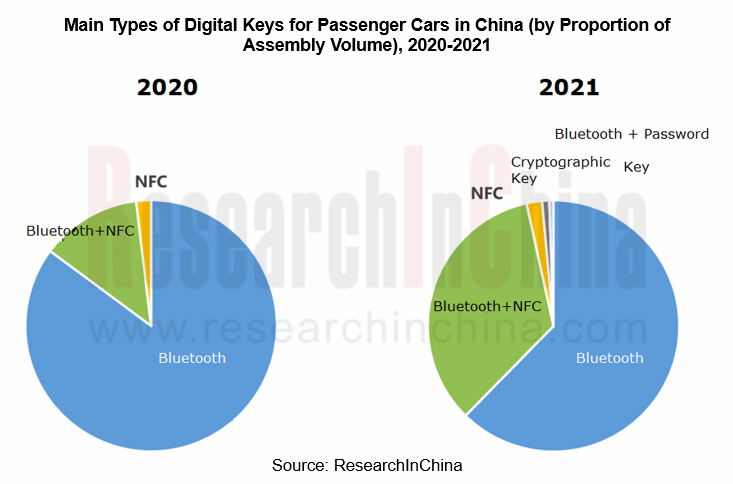
The main advantages of Bluetooth include:
①It is enough to develop only one application platform as per the Global standards;
②All Bluetooth functions can be connected to a main control device of a car, reducing complexity and cost;
③Bluetooth supports two-way communication, eliminating the need for special tools and reducing development complexity and cost;
④Bluetooth features higher security than the existing RF solution;
⑤It is easy to connect devices such as smartphones directly to cars.
In the future, Bluetooth will play an increasingly bigger role in digital keys, autonomous driving and smart cockpits, and will continue to occupy a dominant position in digital key solutions.
Trend 3: UWB solutions start to be available in cars
In 2022, the market will see the mass production and assembly of UWB keys. BMW will introduce the BMW Digital Key Plus based on the ultra-wideband (UWB) technology promoted by Apple to its 2022 models. NIO will install UWB digital keys for ET7 and ET5 to be delivered in 2022 for centimeter-level high-precision positioning. In addition, Samsung is also cooperating with automakers such as BMW, Audi, Hyundai, and Ford in UWB technology.
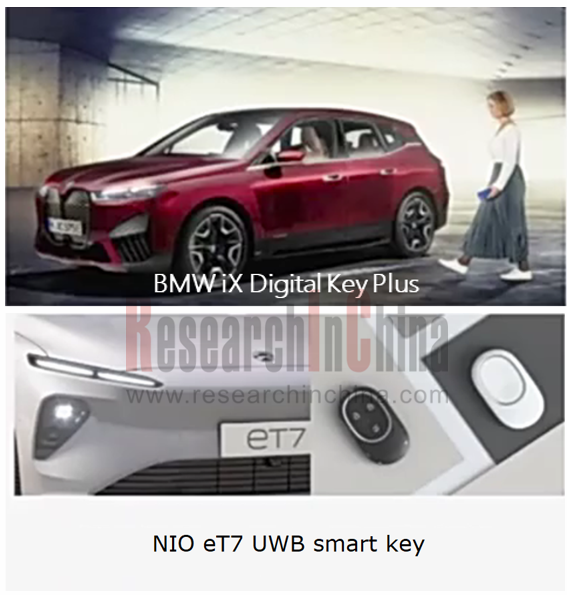
UWB boasts advantages like high positioning accuracy, high transmission rate, high security, and low power consumption. It can meet the wireless connection requirements of users in different scenarios. Especially in terms of security, UWB technology can better prevent relay attacks and prevent radio signals from being intercepted or interfered.
Thanks to high-precision positioning, UWB will be used in vehicles more often.
①Vehicle anti-theft, automatic trailer hitch, in-vehicle occupant monitoring, etc. (developed by Volkswagen & NXP)
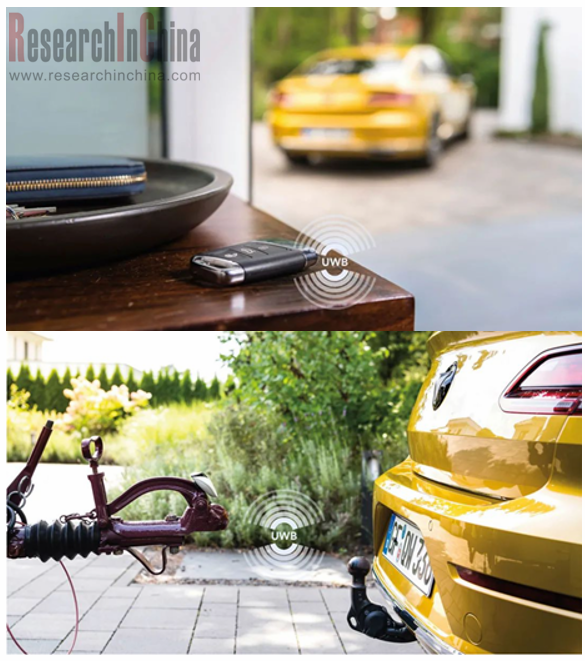
②Anti-theft, keyless entry, remote parking, autonomous driving, micro-navigation, AR-HUD, proximity sensing, vehicle interior detection, rain sensing, etc. (developed by Continental Group)
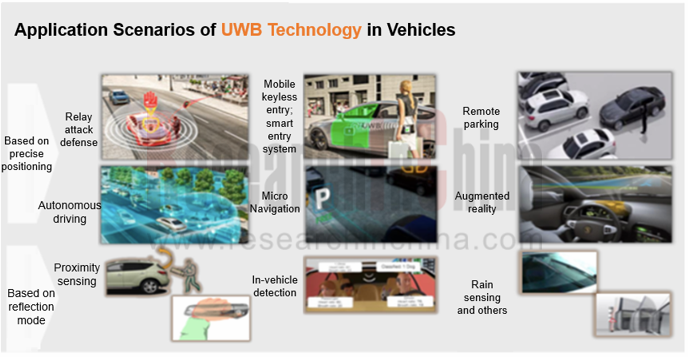
③Tailgate kick, liveness detection (developed by TSINGOAL)
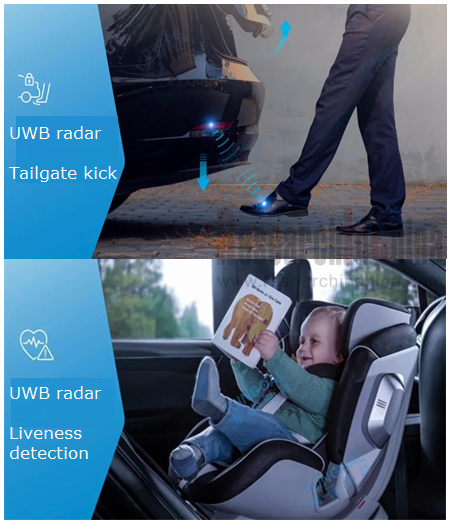
Trend 4: The collaborative solution of NFC+BLE+UWB is expected to become the mainstream
The combination of NFC, BLE (Bluetooth) and UWB is the best solution for digital keys at this stage. Whether it is long-distance, short-distance, or the network environment is weak or the mobile phone is turned off, vehicles can be unlocked smoothly. Specifically, Bluetooth is used to wake up UWB and encrypt data transmission; UWB is used for precise positioning, and NFC enables access when the phone is out of power. At present, foreign suppliers represented by NXP and domestic solution suppliers like INGEEK are all developing this solution.
NXP
Based on core technologies such as NXP automotive UWB IC NCJ29D5 (B/D), automotive Bluetooth SOC KW38, and automotive MCU S32K144, the fusion solution can unlock and start vehicles through NFC-enabled smartphones, remote keys, or NFC smart cards with digital keys.
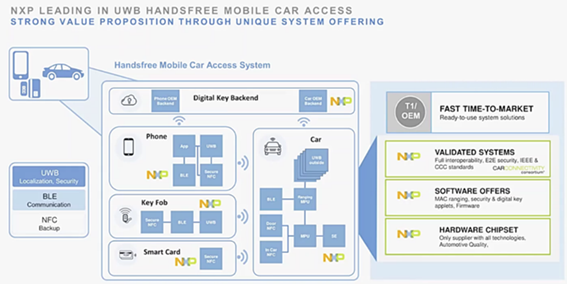
INGEEK
As the mainstream digital key product solution provider, INGEEK released the next-generation smart digital key in October 2021, which adopts BLE, NFC, UWB and other technologies to unlock vehicles with smartphones or watches and completely replaces physical keys. The system fully connects intelligent cockpit, telematics and Internet social platform to realize complete personalized user experience.
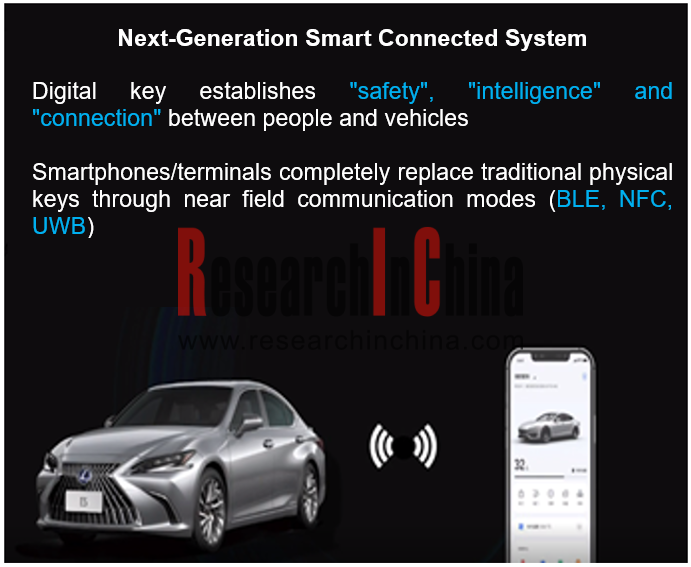
Trend 5: Digital keys will carry more functions amid the trend of smart mobility
In addition to sensorless entry/start, remote viewing/control, digital keys have more potentials in functions and scenarios.
In the short term, C-side functions in scenarios (such as personalized settings, vehicle sharing, and autonomous driving) and B-side functions (like shared car operation, sales & after-market services, and fleet management) will be the focus that can be tapped. In the long run, digital keys will connect with more ecosystems and carry more functions amid the trend of smart mobility.
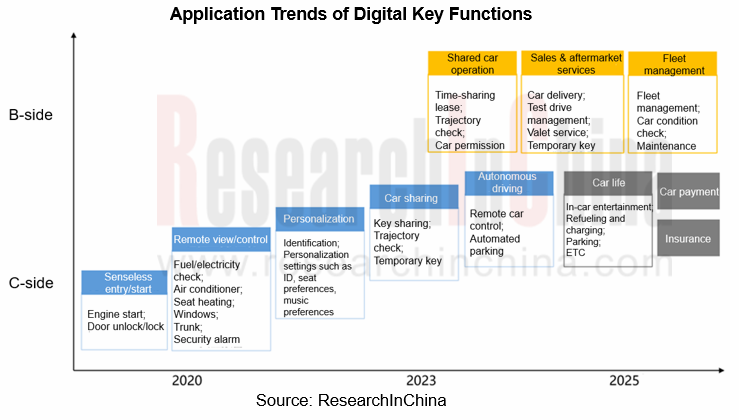
Autonomous Driving Simulation Industry Chain Report (Chinese Companies), 2022
Simulation Research (Part II): digital twin, cloud computing, and data closed-loop improve simulation test efficiency.
Simulation tests can not only be conducted in extreme working conditions and mor...
Automotive Memory Chip Industry Research Report, 2022
Automotive Memory Chip Research: Localization is imperative amid intense competition
The global smart phone storage market size hit US$46 billion in 2021 when the global automotive storage market siz...
Autonomous Driving Simulation Industry Chain Report (Foreign Companies), 2022
Simulation test research: foreign autonomous driving simulation companies forge ahead steadily with localization services.
As the functions of ADAS and autonomous driving systems are developed and th...
China Automotive Multimodal Interaction Development Research Report, 2022
Multimodal interaction research: more hardware entered the interaction, immersive cockpit experience is continuously enhanced
ResearchInChina's “China Automotive Multimodal Interaction Development Re...
Global and China Automotive Operating System (OS) Industry Report,2022
Operating system research: the automotive operating system for software and hardware cooperation enters the fast lane.
Basic operating system: foreign providers refine and burnish functions; Chinese ...
Automotive Millimeter-wave (MMW) Radar Industry Report, 2022
Automotive radar research: installations surged by 49.5% year on year in 2021, and by 35.4% in the first nine months of 2022.
1. The installations of automotive radars sustain growth, and are expect...
Automotive DMS/OMS (Driver/Occupant Monitoring System) Research Report, 2022
In-cabin Monitoring Research: In the first nine months of 2022, the installations of DMS+OMS swelled by 130% yr-on-yr with visual DMS/OMS as the mainstream solution
Local manufacturers are keen to de...
NIO ET5/ET7 Intelligent Function Deconstructive Analysis Report, 2022
NIO ET5/ET7 Intelligent Function Deconstruction: R&D will change the market pattern in 2025Chinese automakers have triumphed remarkably in the field of high-end intelligent electric vehicles. Afte...
Automotive Smart Cockpit Design Trend Report, 2022
Research on design trends of intelligent cockpits: explore 3D, integrated interaction. ...
Commercial Vehicle Telematics Report, 2022
Commercial vehicle telematics research: three parties make efforts to facilitate the industrial upgrade of commercial vehicle telematics.
In 2022, China's commercial vehicle telematics industry cont...
Passenger Car Intelligent Steering Industry Research Report, 2022
Research on intelligent steering of passenger cars: The development of intelligent steering is accelerating, and it will be put on vehicles in batches in 2023
In September 2022, Geely and Hella joi...
China Charging / Battery Swapping Infrastructure Market Research Report, 2022
Research of charging / battery swapping: More than 20 OEMs layout charging business, new charging station construction accelerated
From January to September 2022, the sales volume of new energy vehic...
China L2 and L2+ Autonomous Passenger Car Research Report, 2022
L2 and L2+ research: The installation rate of L2 and L2+ is expected to exceed 50% in 2025.So far, L2 ADAS has achieved mass production, and L2+ ADAS has seen development opportunities as the layout f...
Global and China L4 Autonomous Driving and Start-ups Report, 2022
L4 autonomous driving research: the industry enters a new development phase, "dimension reduction + cost reduction".
L3/L4 autonomous driving enjoys much greater policy support.
...
Software-defined vehicle Research Report 2022- Architecture Trends and Industry Panorama
Software-defined vehicle research: 40 arenas, hundreds of suppliers, and rapidly-improved software autonomyThe overall architecture of software-defined vehicles can be divided into four layers: (1) Th...
Emerging Automaker Strategy Research Report, 2022 - Li Auto
Research on Emerging Automaker Strategy: the strategic layout of Li Auto in electric vehicles, cockpits and autonomous driving
Li Auto will shift from the single extended-range route to the “extended...
Commercial Vehicle Intelligent Chassis Industry Report, 2022
Commercial vehicle industry is characterized by large output value, long industry chain, high relevance, high technical requirements, wide employment and large consumer pull, and is a barometer of nat...
China TSP and Ecological Construction Research Report, 2022
TSP research: the coverage of TSPs has spread from IVI, cockpits to vehicles.
With the emergence of Internet of Vehicles, telematics service providers (TSPs) take on the roles of operation platforms,...